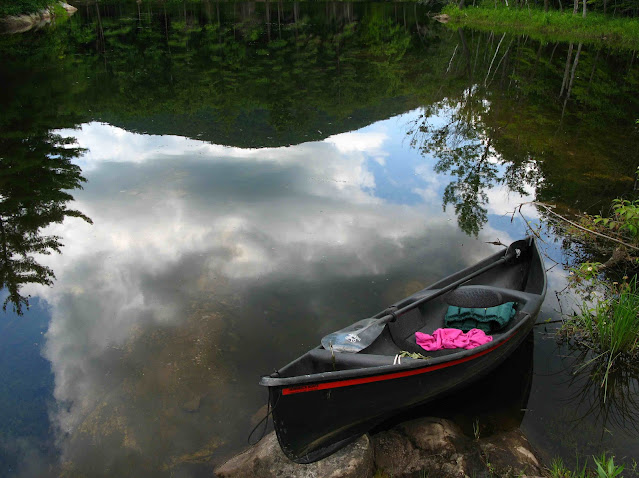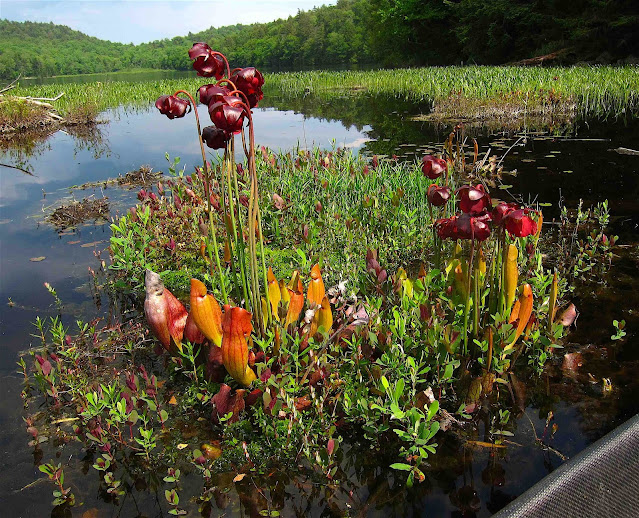I just learned that today-- 2/2/22 -- is World Wetlands Day. Because of the many benefits we get from wetlands, World Wetlands Day is observed on February 2 every year to raise awareness about their importance and the need to preserve them. Wetlands are regions where water covers the soil for an extended period of time, creating ideal conditions for the growth of highly adapted plants and animal species. Wetlands play a critical role in maintaining natural cycles and supporting a wide range of biodiversity. They purify and filter waste from the landscape and regulate and replenish our water. For many, wetlands are the primary sources of fresh water and also serve as natural buffers against floods and droughts. Most importantly, wetlands minimize the impacts of climate change. This year's celebration is particularly significant, since 2022 is the first year that World Wetlands Day will be observed as a United Nations international day.
I certainly couldn't let this day go by without celebrating it, especially since I possess a perfect little super-lightweight Hornbeck canoe (12 pounds!) that allows me access to so many different kinds of wetlands: rivers, lakes, swamps, and bogs. Here are just a few of the beautiful wetlands my little boat (pictured above) has carried me to. (And also one I could just walk into on foot.)
Lens Lake is surrounded by mountains and abounds with acres of floating bogmats. Snowy tufts of Cottongrass dance on slender stalks above the Sphagnum Moss that carpets the bogmats. Sphagnum Moss is essential for creating the acidic habitat so distinctive of this type of wetland.
Wetlands along Bog Meadow Brook Nature Trail
I don't need my canoe to access the wetlands of this nature preserve just east of Saratoga Springs, since this well-maintained foot trail (a former railway line) passes right through the middle of them. The scarlet fruits of a Winterberry shrub (Ilex verticillata) glow from the shadowy depths of the acres and acres of wooded wetlands that surround this trail. Despite the trail's name, this particular wetland is technically a swamp, with a higher pH habitat than would be the case for a true acidic bog.
Early Azalea (Rhododendron prinophyllum) is another shrub that thrives in the wooded wetlands along Bog Meadow Brook Nature Trail. This shrub grows well back in the forest, hidden from casual view, but I can detect its exquisite fragrance when it blooms and thus know when to search for it.
There actually ARE a few genuinely boggy areas long the Bog Meadow Brook Nature Trail, low-pH pools that are rimmed with Sphagnum Moss and populated thickly with the wetland plant called Bog Buckbean (Menyanthes trifoliata).
The Hudson River at Moreau, New York
Small rocky islands dot the Hudson River below Spier Falls Dam at Moreau. Because of the current, the water is often open even in the depths of winter, attracting Bald Eagles to fish in its waters.
In the quiet catchment between the Spier Falls and Sherman Island dams, where the current of the Hudson is slowed, the river flows back behind a large island and into small sheltered coves. The bouldered shores are home to many beautiful native shrubs and wildflowers, some of them rare.
Moreau Lake at Moreau Lake State Park
Moreau Lake lies at the heart of Moreau Lake State Park in Moreau, NY.
This kettle lake is only one of the wetlands within this 7,000-acre park that features two other lakes (Bonita and Anne), which are high in the mountains that surround Moreau Lake. There are also beaver ponds, tupelo swamps, vernal pools, and mountain streams to be found in the Palmertown Range of mountains that runs through the park. Moreau Lake State Park also incorporates several miles of Hudson River shoreline in both Saratoga and Warren counties. No shortage of various wetlands in this park! And over the years, I have found at least 8 rare-to-endangered wildflowers and 15 species of native orchids among the various habitats of this marvelous park.
Pyramid Lake in Essex County, New York
Pyramid Lake is one of the jewels of the Adirondacks. It is located in the Pharaoh Lake Wilderness Area and thus is protected as "forever wild." Thanks to calcareous rock that underlies this lake, the water, islands, and shoreline are home to many plants that require a basic (not acidic) habitat.
A very small sampling of some wildflowers that thrive in various wetland habitats:
Marsh Marigold (Caltha palustris) carpets many different shallow wetlands -- including roadside ditches -- with its big yellow blooms quite early in the spring.
The blazing-red Cardinal Flower (Lobelia cardinalis) and the bright-blue Pickerelweed (Pontederia cordata) share the riverbanks together in late summer.
The exquisite Fragrant Water Lily (Nymphaea odorata) never floats less-than-perfect blooms on the surface of lakes or ponds, because as soon as the flower is pollinated, its stem retracts to plant its fertilized ovary down in the muddy bottom of the lake.
The gorgeous Grass Pink Orchid (Calopogon tuberosus) blooms abundantly in many of northern New York's sphagnum bogs. Many of our state's nearly 60 species of native orchids prefer the acidic habitat and cold water of northern bogs.
I don't believe there is a more quintessential northern wetland plant than our Purple Pitcher Plant (Sarracenia purpurea), a typical resident of sphagnum bogs but also of slightly less-acidic fens and lakeshores. This lovely clump was growing along the swampy shore of Sand Lake near Newcomb, in Essex County, NY.
I don't find Three-leaved Solomon's Seal (Maianthemum trifolium) in every acidic wetland I explore, but if it IS in residence and blooming, I can often detect it by its fragrance before I even see it. It will often carpet the wetland with such abundance it resembles the stars in the sky.

















4 comments:
Wonderful, Jackie! What a nice reminder of what is in store for us this summer.
Great photos -- wetlands are truly fascinating places.
What a wonderful celebration of wetlands! I didn't know about 2/2/22. Loved the picture of Pitcher Plant!
In 'A Guide to the Natural Communities of Vermont' 40 different types of wetlands are described. Some of these have several variants as well. Moisture, pH, elevation and successional stage interact to create unique conditions that favor some plants over others. That's enough diversity to keep a naturalist busy for a lifetime!
Post a Comment